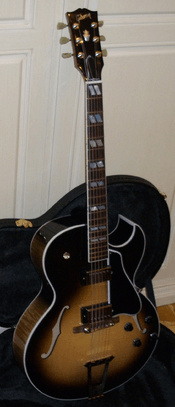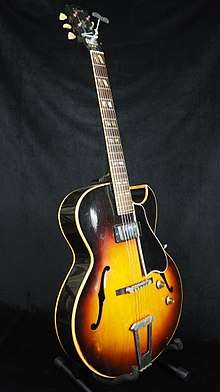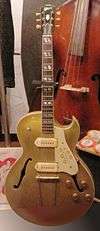Gibson ES-175
The Gibson ES-175 is an electric guitar manufactured by the Gibson Guitar Corporation. It was dropped from the Gibson lineup for 2019 after 68 years in continuous production. It is a 243⁄4" scale full hollow-body guitar with a trapeze tailpiece and Tune-O-Matic bridge. It is one of the most famous jazz guitars in history.
| Gibson ES-175 | |
|---|---|
 | |
| Manufacturer | Gibson |
| Period | 1949–2017 |
| Construction | |
| Body type | Hollow |
| Neck joint | Set |
| Woods | |
| Body | Maple, Poplar, Maple laminate, Mahogany (back and sides, 1983–1990) |
| Neck | Mahogany |
| Fretboard | Rosewood |
| Hardware | |
| Bridge | Tune-O-Matic bridge with rosewood base |
| Pickup(s) | One single-coil (1949–1953); two single-coils (1953–1957); two humbuckers (1957–present); models with one humbucker or two single-coils are still available |
| Colors available | |
| Antique Natural, Vintage Sunburst, Wine Red | |

Features
The ES-175 is a single- or dual-pickup archtop electric guitar made by Gibson. Unlike Gibson's L5 and Super 400 guitars, the ES-175 typically has an all-laminate construction, which allows the cost of materials and construction to be kept down, as well as assisting in keeping feedback at higher volumes manageable.
The ES-175 has a rosewood fingerboard with parallelogram inlays, a 3" deep body, a floating bridge, one or two humbuckers (current models are equipped with Gibson's 57 Classic pickups, replicas of the PAF pickups from the late 1950s), 20 frets (earlier models had 19 frets) and independent volume and tone controls for each pickup. The guitar has the standard Gibson scale length of 24.75" and normally has a sunburst and natural finish, though Gibson has produced limited runs in black, white, and wine red. Hardware is usually chrome or nickel, with limited runs of gold-plate.
The ES-175 was designed to be a cheaper alternative to Gibson's high-end archtop models
History
The ES-175 debuted in 1949, as Gibson's mid-level laminate top alternative to the L-5 and as an electric version of the L-4. It was also the first Gibson electric to feature a stylish Florentine cutaway. Its first incarnation had one single-coil pickup (a P-90) in the neck position, and a carved rosewood bridge. The model's name is derived from its original price of $175. In 1953, the ES-175D, a two-pickup model, was introduced (previous to this a two-pickup model could be custom ordered, and came with a volume knob for each pickup and a master tone located on the lower bout). The ES-175 or ES-175D could be ordered in either sunburst finish or in natural finish (for an additional charge).
Beginning in February 1957, ES-175s came equipped with humbuckers. Many new jazz guitarists such as Pat Metheny used these to emulate the sound of Joe Pass and Wes Montgomery's "heart" L5. The ES-175 with humbuckers is prized for its full, rich tone.
In 1969, shortly before Norlin acquired Gibson from CMI (Chicago Musical Instruments), Gibson began to implement changes across the line, including changing the headstock pitch from 17 degrees to 14, phasing in three-piece maple necks in lieu of one piece mahogany, and the addition of a volute to the neck. The ES-175 was largely spared these changes until the mid-1970s. In 1976, the three-piece maple neck replaced the one-piece mahogany neck, a volute was added, and the wooden bridge was replaced by a Nashville bridge.
By the mid-1970s, Gibson had discontinued the single-pickup model.
In 1976 Gibson introduced the ES-175T, a thin-body variant on the ES-175 (much like an ES-125TCD with more fancy appointments). It was made for only three years, and available in sunburst, natural (more expensive) and wine red. The model proved fairly unpopular and was discontinued in 1979.
In 2002, Gibson released a Steve Howe signature model, based on Howe's 1964 ES-175. In 2012, Gibson released a pair of 1959 ES-175 reissues, a single-pickup and a dual-pickup model. It is the first production ES-175 single pickup model since the 1970s.
Jazz guitarist Joe Pass played his ES-175, donated to him ca. 1962, for many years. This model guitar is used not only by jazz guitarists. Scotty Moore, the guitarist for Elvis Presley, played an ES-295, dual P-90-equipped, all gold ES-175.[1][2] Steve Howe also plays an ES-175. Gibson released the Herb Ellis ES-165 as a signature reissue of his original 1953 ES-175[3]. Roddy Frame used one during the first years of Aztec Camera.
The Epiphone company also produces an ES-175 model, available only in golden and black colours. The Epiphone model has an arched back as well. It is also equipped with two AlNiCo wax-dipped humbuckers.[4] It also produced an ES-295, with all the original trimmings, plus a B-7 bigsby vibrato tailpiece.
Notable ES-175 users
Variations
ES-165
ES-295

The ES-295 was introduced in May 1952 as an upscale version of the ES-175. It shared the same specifications as the ES-175, except it came in Gibson's Bullion Gold and featured a combination trapeze bridge/tailpiece with strings looping over the bridge, rather than a floating bridge. It also featured a clear plastic pickguard, back-painted in cream and embossed with a gold floral design. The ES-295 prototype was built in 1951 by Gibson at the request of Les Paul, who wished to present a gold ES-175 to a wounded veteran.[5]
Discontinued in 1959, it was reissued in 1994 with the earlier P-90 pickup design, as opposed to humbuckers it had been equipped with since 1957, and a Bigsby vibrato tailpiece, replacing the original trapeze tailpiece design.[6] Epiphone released a Korean made ES-295 model, also with P-90s and a Bigsby. Gibson Memphis released a recreation of a 1952 ES-295 with P-90s and original trapeze tailpiece design, offered in Bullion Gold and a limited edition Sixties Cherry stain.
Notable ES-295 players include Mary Ford, who played one while touring with Les Paul in the early 50s[7], Scotty Moore, who used an ES-295 as his primary guitar for most of the Sun recordings with Elvis Presley[8], and Geordie Walker of Killing Joke.
References
- Bacon, Tony. Electric Guitars - The Illustrated Encyclopedia
- Marshall, Wolf. Best of Jazz Guitar, pp. 4–5
Other references
- Carter, Walter (2007). The Gibson Electric Guitar Book: Seventy Years of Classic Guitars. Hal Leonard Corporation. p. 42. ISBN 9780879308957. Retrieved 28 March 2012.
- Marcus, Greil; Dregni, Michael; Guralnick, Peter; Luc Sante; Robert Gordon; Sonny Burgess (2011). Rockabilly: The Twang Heard 'Round the World: The Illustrated History. Voyageur. p. 40. ISBN 9780760340622. Retrieved 28 March 2012.
- Herb Ellis's original 1953 ES-175 (serial #A-13645) currently owned by Chuck Nicholson of Jen St. Stjarna and That Rhythm, Man.
- "Epiphone ES-175". Epiphone.com.
- "1953 Gibson ES-295". Fretted Americana Inc.
- "ES-295 Electric Archtop". Vintage Guitars Info.
- "1952 Gibson ES-295 Electric Guitar". Antiques Roadshow.
- "ES-295 Scotty Moore". Gibson.com. Archived from the original on 2015-12-22.
External links
| Wikimedia Commons has media related to Gibson ES-175. |
- Gibson ES-175. gibson.com. Retrieved May 8, 2009.
- History of the Gibson ES-175